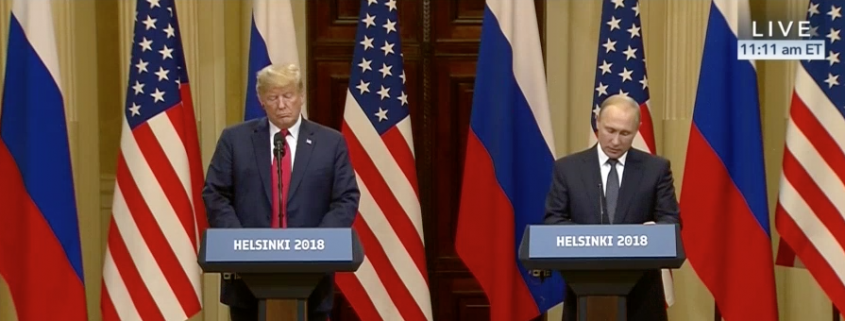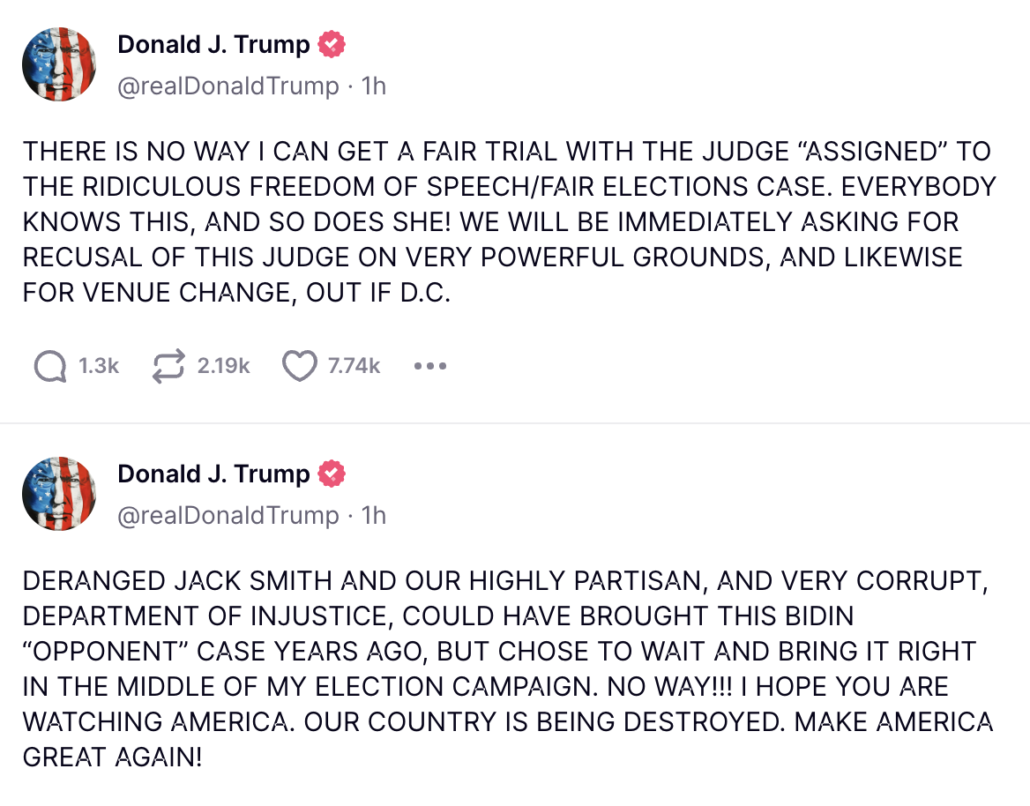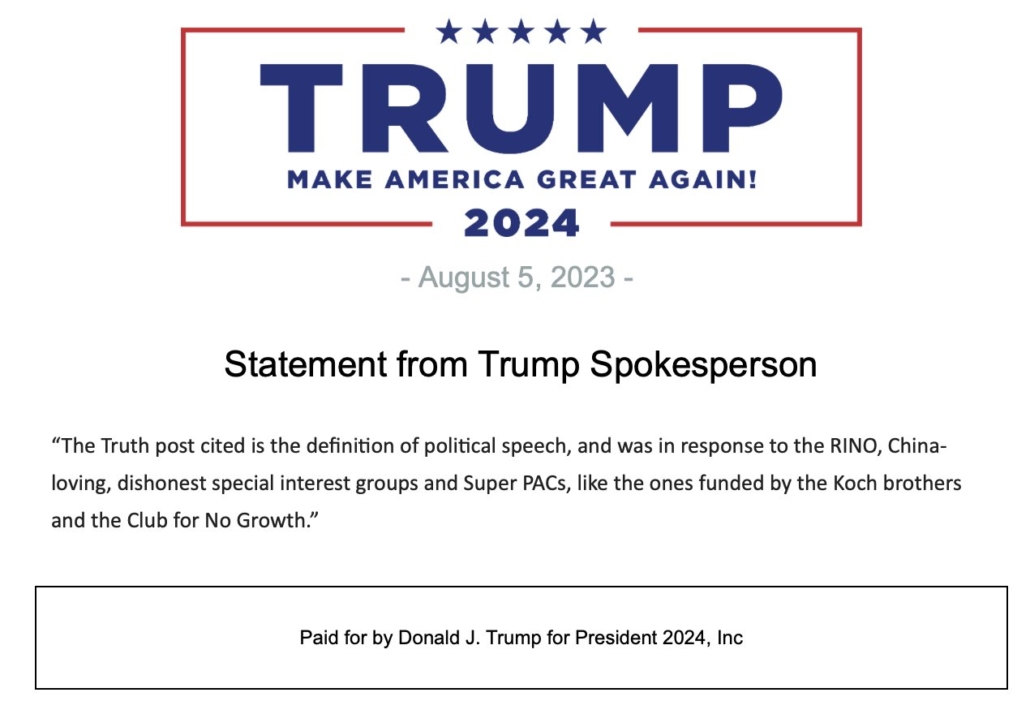In the last day, Maggie and Mike and Devlin and Dawsey came out with twin pieces that purport to assess the legal strength of the indictment against Trump, but instead simply say, “well, Trump believes his bullshit and so do we and so the charged conduct may be First Amendment protected.”
Neither of these articles even mention that 18 USC 371, conspiracy to defraud the US, is about lying to the US, even though one of the lawyers cited by WaPo attempted to explain that to them.
Here’s why all those claims that Trump knew he was lying are in the indictment: because his false claims were the means Trump used to carry out the conspiracy to defraud.
The Defendant widely disseminated his false claims of election fraud for months, despite the fact that he knew, and in many cases had been informed directly, that they were not true. The Defendant’s knowingly false statements were integral to his criminal plans to defeat the federal government function, obstruct the certification, and interfere with others’ right to vote and have their votes counted. He made these knowingly false claims throughout the post-election time period, including those below that he made immediately before the attack on the Capitol on January 6:
This indictment will be measured not by what Maggie and Mike and Devlin and Dawsey claim about legal statutes they haven’t bothered to explain.
It will be measured by whether the government presents evidence to prove the elements of offense for each charge beyond a reasonable doubt.
Here, in abbreviated form, is what the elements of the offense are for the four charged crimes, which is what the jury will be given to judge the former President’s crimes. DOJ will need to prove that Trump entered into three parallel conspiracies with his alleged co-conspirators, then show that they attempted to:
- Use deceit to undermine the Electoral College Act
- Prevent the certification of the Electoral votes on January 6
- Prevent the Biden voters votes in swing states from being counted
Conspiracy
Trump is charged with conspiring with six people: Rudy Giuliani (CC1), John Eastman (CC2), Sidney Powell (CC3), Jeffrey Clark (CC4), Kenneth Chesebro (CC5), and either Boris Epshteyn or Mike Roman (CC6). DOJ did this because to prove the case against Trump, it plans to introduce the words and actions of each of these six people as co-conspirators. To admit that as evidence, DOJ will need to convince Judge Tanya Chutkan that Trump entered into an agreement with each of them to carry out the goal of each of three conspiracies, which are:
- 18 USC 371: The purpose of the conspiracy was to overturn the legitimate results of the 2020 presidential election by using knowingly false claims of election fraud to obstruct the federal government function by which those results are collected, counted, and certified. The government function Trump is accused of seeking to thwart with all his lying is the Electoral Count Act, the means by which the government ascertains the winners of each state’s electoral college votes.
- 18 USC 1512(k): The purpose of the conspiracy was to corruptly obstruct the vote certification on January 6.
- 18 USC 241: The purpose of the conspiracy was to prevent people’s votes from being counted, probably best defined as the Biden voters whose votes made him the winner of swing states, with Georgia, Michigan, Nevada, Pennsylvania, and Arizona mentioned explicitly.
The government doesn’t have to prove that all seven of these people sat in a room and made an agreement on November 14, the day after Trump’s campaign conceded Arizona, which is when the alleged conspiracies began. Nor does it have to prove they entered into an explicit agreement. They just need to prove that each of these people agreed to pursue the goal of each conspiracy.
The kinds of things the government will use to prove the co-conspirators joined this conspiracy are:
Rudy: The government will show that on November 14, Rudy took over Trump’s efforts to contest the vote (remember that DOJ subpoenaed whatever legal arrangement he had with Trump, but note that Special Master Barbara Jones appears to have found none of Rudy’s post-election plotting to be privileged). It will show that, acting on Trump’s instructions, Rudy repeatedly contacted both state officials and members of Congress to assert fraud that even he admitted he had no evidence for. “We don’t have the evidence, but we have lots of theories.” It will show that Trump repeatedly publicly ratified Rudy’s lies, often by Tweeting the claims Rudy made, and often by pushing them both with state officials he was personally trying to pressure, but also with US government officials, including DOJ.
John Eastman: The government will show that as Trump tried to find some justification for stealing the election, he turned to Eastman to give it legal cover. It will point to things like the Georgia lawsuit certification Trump signed on December 31 that Eastman acknowledged included false data. It will show Eastman’s calls in support of fake electors. It will rely heavily on the meetings Eastman personally attended in the days leading up to January 6. It will show that Trump decided, after being told repeatedly that Mike Pence wouldn’t throw out the votes, to have Eastman (as well as Rudy) speak at the Ellipse rally.
Sidney Powell: As I noted in this post, the role of Powell as alleged in the conspiracy is actually quite narrow. The indictment shows that on November 16, Trump asked Powell and others to use the Dominion voting machine allegations in lawsuits, and starting on November 25, she did so. Trump ratified her actions, even though Rudy had publicly split from her, on Twitter. One of the lies the indictment claims Trump knowingly told — in addition to very specific lies about swing states he repeated in his Ellipse speech — pertains to the voting machines, and to prove that lie, the government will show Trump knew Powell was batshit crazy but didn’t care.
Jeffrey Clark: The government will show that, starting on December 22, after Bill Barr, Jeffrey Rosen, and Richard Donoghue all debunked Trump’s false claims, Clark had secret communications with Trump that violated DOJ’s contact policy. As a result of those secret communications, Clark drafted a letter he attempted to coerce Rosen and others to sign, endorsing the fake elector scheme. Trump endorsed his actions by attempting to (and briefly at least, in fact replacing) Rosen with Clark so Clark could, “use the authority of the Justice Department to falsely present the fraudulent electors as a valid alternative to the legitimate electors.”
Kenneth Chesebro: The government will show that, acting at the direction of people acting for Trump, Chesebro wrote a series of increasingly radical memos laying out how each swing state ascertained electors and describing how fake electors could attempt to comply with those laws, even while acknowledging that in several states they couldn’t meet the legal requirements. (Here’s the J6C Report on the memos.) The government will show that Chesebro entered into the conspiracy via communications with Rudy and, later, Eastman, not directly with Trump.
Co-Conspirator 6: It’s not yet certain whether CC6 is Boris Epshteyn or Mike Roman. Whoever it is, DOJ will show that CC6 played a key role in recruiting people to implement the fake elector scheme and then was involved in Rudy’s attempts to persuade members of Congress to reject the swing state electoral certificates.
Conspiracy to Defraud the United States
Assuming DOJ can convince Judge Chutkan that each of these people entered into a conspiracy with Trump, it will then use his own actions and theirs to prove the elements of offense for each of the charged conspiracies.
For 18 USC 371, the government needs to prove that Trump and his co-conspirators attempted to use deceit to pretend that Trump had won 306 electoral college votes, rather than Joe Biden. This statute is why the discussion of all the lying is in there.
Notably, assuming Chutkan agrees these are all co-conspirators, DOJ won’t have to rely entirely on Trump’s lies. They’ll also rely on:
- Rudy’s admission to Rusty Bowers they had no evidence to back their claims
- Eastman’s admission to Mike Pence his claims about ECA were untested, and his admission to Greg Jacob that SCOTUS would reject them
- Trump’s description of Sidney Powell’s claims as crazy
- Jeffrey Clark’s attempts to deceive his bosses about what he was doing with Trump
- Kenneth Chesebro’s admission that the fake electors in several states could not comply with the law
As I have laid out, DOJ has set up 5 specific lies that Trump recycled in his Ellipse speech after having them repeatedly debunked by Republicans, along with the voting machine lies Sidney Powell told. They have also laid out that Trump lied about what Pence had just told him (and there are contemporary witnesses that it happened before Trump made his false claims about Pence).
Even if jurors believed Trump believed his own bullshit about some or all of the claims about fraudulent votes, DOJ would still have Trump’s lies about Dominion voting machines and Pence to prove that he knowingly defrauded the US.
Obstruction of the Vote Certification
As I have repeatedly noted, for both obstruction counts (charged as a conspiracy and against Trump alone), dozens of other January 6 defendants have already tried the defense that Maggie and Mike and Devlin and Dawsey present (and not for the first time by Maggie and Mike) as if Trump would be making it for the first time.
It didn’t work. I will link, once again, Royce Lamberth’s recent findings of fact in the Alan Hostetter case in the futile hope that Maggie and Mike and Devlin and Dawsey might decide to learn how this statute has already been applied in hundreds of January 6 cases.
To prove that Trump (and his co-conspirators for the 1512(k) charge) obstructed the vote certification, DOJ will need to:
- Prove that Trump knew the significance of the vote certification (possibly both the December 14 and January 6 ones). DOJ will point to both the effort to get fake elector certificates created on December 14, and Trump’s publicity of January 6 and his repeated public claims that unless Pence intervened, he wouldn’t be President anymore.
- Prove that Trump took steps to obstruct the certification of the votes. DOJ will point to the pressure on Mike Pence, both covertly in meetings leading up to January 6 and overtly after Pence told Trump he would not reject the certifications. DOJ will also point to things Trump did to ensure that a mob of bodies physically occupied the Capitol, and after they had ,refuse to take steps in response to requests from people like Kevin McCarthy and Pat Cipollone to get them out of there.
- Prove that Trump had a corrupt purpose in doing all this. As I keep saying, what the standard for corrupt purpose will be is being decided as we speak by the DC Circuit (and yesterday, the effective solicitor general for the mobsters filed for cert at SCOTUS in an attempt to preempt the DC Circuit). It will be some combination of the following:
- Otherwise illegal acts: DOJ would prove that Trump violated the law to obstruct the vote certification by looking at the fake elector plot and the knowingly illegal order to Pence.
- Corrupt personal benefit: Among the hundreds of people charged with obstruction, this definition of corrupt purpose is probably easiest to prove for Trump, because he was attempting to remain President after being fired by voters. This is one area where Trump’s awareness that he lost might matter, but ultimately, the Lamberth decision would lay out that even if Trump really believed he won, the means he used to prevent Biden’s vote from being certified were corrupt.
Conspiracy to Prevent Biden’s Voters Votes from Being Counted
After laying out the elements of offense for joining a conspiracy, the jury instructions in the Douglass Mackey case used the following language for the objective of the conspiracy.
The indictment alleges that the objective of the charged conspiracy was to injure, oppress, threaten or intimidate one or more persons in the free exercise and enjoyment of their right to vote. The government must therefore prove beyond a reasonable doubt that the defendant knowingly and intentionally joined the conspiracy with the intent to further that objective. In this case, the government has alleged that the object of the conspiracy was specifically to “injure” one or more persons in the free exercise and enjoyment of their right to vote. I instruct you that the statute covers conduct intended to “obstruct,” “hinder,” “prevent,” “frustrate,” “make difficult or impossible,” “or indirectly rather than directly assault” free exercise of the right. For example, “hinder” is defined as “to make slow or difficult the progress of, to hamper, to hold back, to prevent, to check.”
It does not require the possibility of physical force or physical harm. Thus, conduct that makes the right to vote more difficult, or in some way prevents voters from exercising their right to vote can constitute an “injury” within the meaning of the law.
Here, the object of the conspiracy was twofold: to prevent people from voting, but also to prevent their votes from being counted.
Curiously, the timeline on this conspiracy only starts at November 14, after all the votes were cast.
The indictment notes several instances where Trump intimidated people counting the vote, mentioning the death threats that he caused Al Schmidt and Ruby Freeman and Shaye Moss to suffer. It explicitly states that Trump, “attempted to use a crowd of supporters that he had gathered in Washington, D.C., to pressure the Vice President to fraudulently alter the election results.” It describes how the lies (as well of those from Eastman and Rudy) in his Ellipse speech:
gave false hope that the Vice President might change the election outcome, and directed the crowd in front of him to go to the Capitol as a means to obstruct the certification and pressure the Vice President to fraudulently obstruct the certification
It describes how, after being told of the riot, Trump further inflamed the crowd with a tweet targeting Pence the minute before Pence was evacuated for his safety (thereby shutting down the vote count). It describes how Trump refused the requests of Pat Cipollone, Pat Philbin, Mark Meadows, a Deputy Chief of Staff (possibly Tony Ornato), and Eric Herschmann to tell the rioters to leave. It describes how Trump refused Cipollone’s request that he withdraw his objections to the vote certification.
The comments and actions of both Rudy and John Eastman also nakedly show that the intent was to prevent Joe Biden’s votes from being counted.



